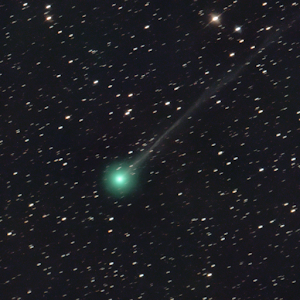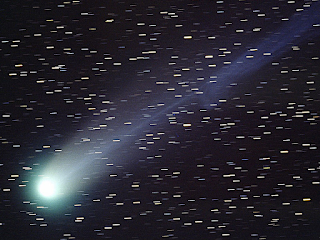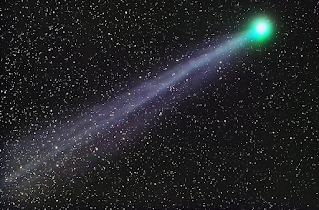Why's Nishimura Green?
 |
| Comet Nishimura (C/2023 P1) as photographed on August 25, 2023. Credits: Public Domain, via Wikimedia Commons. |
 |
| Comet Hyakutake as photographed during its closest approach to Earth on March 25, 1996. Credits: Public Domain, via Wikimedia Commons. |
 |
| Comet ISON as photographed on October 8, 2013. Credits: Public Domain, via Wikimedia Commons. |
The list of green comets continues with Comet Lovejoy (C/2014 Q2), a great candidate. Next in line comes C/2017 S3 (PANSTARRS) or the Incredible Hulk. Earlier this year, C/2022 E3 (ZTF), first discovered in 2022 by the Zwicky Transient Facility - an automated telescope tasked with mapping the night sky from Mount Palomar, California, stole the show. A peculiar candidate, it looked unusually green. As always, dubbed the Green Comet, it became an immediate media sensation.
 |
| Lovejoy during its 2014 apparition as photographed on January 19, 2015. Credits: Public Domain, via Wikimedia Commons. |
With so many green comets around, this begs the question, why are comets green? Why's Nishimura green?
Comets are Dwellers in Darkness. They are an agglomerate of myriad hydrocarbons frozen solid, from methane, ethane, ethanol, formaldehyde, complex long-chain hydrocarbons, and viz., plus frozen carbon dioxide, carbon monoxide, ammonia, and water ice, mixed with rock, dust, and dirt. They are the leftovers from the early days of the solar system's formation. Some comets are so old that their chemical makeup predates the solar system. Away from the center stage, comets circle the Sun in a torus-like belt, extending from 30 au at the orbit of Neptune to 55 au. A greater fraction of them hails from the Oort Cloud - a spherical distribution of a trillion-plus cometary bodies reaching far into interstellar space. Like planets, comets remain bound in stable orbits. As long as it's stuck in the Kuiper belt, a comet doesn't even look like what we have been seeing virtually since the dawn of our first ancestors. It's just a piece of rock, debris, that didn't accrete into any planet and instead got banished to the outer edge of the solar system. However, gravitational perturbations, effected by the four giant outer planets Jupiter, Saturn, Uranus, and Neptune, every once in a while, nudge these objects out of their sweet spot, hurling them towards the Sun.
This is where things get interesting. A comet ought to be the least reflective object one can expect to find in the solar system. They do not even hard rock, but organic ice and hydrocarbons amalgamated with rocky stuff. That justifies their nickname, "dirty snowballs " or "icy dirtballs". Frozen solid, traveling ever slowly through the frigid depths, they remain virtually inactive. Their intrinsic color falls between a dark shade of grey, sometimes darker than coal; there's also some seasonal variation of color due to space weathering. With such low albedo, it becomes next-to-impossible to spot a comet's bare nucleus among the background stars. But as it closes in on the Sun, an inconspicuous 3 km wide lump of shapeless rock metamorphoses into a psychedelic light show.
When a comet plummets for the Sun, they do so in highly elliptical orbits. At its far extreme, such an orbit places the comet well beyond a couple of hundred astronomical units from the Sun, known as aphelion. On its closest approach to the Sun, i.e., at perihelion, the comet may fly by under less than 0.2 au or 30 million km approx.(~18 million miles), which is appreciably less than half of Mercury's perihelion. Depending on whether it starts its journey from the Kuiper Belt or the much distant Oort cloud, a comet may fall inwards for decades or tens of thousands to hundreds of thousands of years, respectively. But in both cases, they make their way across the solar system unnoticed until about 5 au from the Sun, where the first discernible change occurs. Around the orbit of Jupiter, the Sun's heat becomes so intense that even subsurface ice sublimes and vents out through the cracks and fissures in the form of high-pressure jets and geysers. These escaping volatiles envelop the comet's nucleus with a thin veil of an atmosphere held in place by the comet's meager gravity. This interim atmosphere is known as a comet's coma. The coma is almost 90% water, with various other organic volatiles and dust filling in the rest. The coma grows in size as the comet falls toward the Sun and can be comparable to Jupiter. Sometimes, the coma may dwarf the Sun in physical dimensions.
 |
| Comet 17/P Holmes as seen on November 2, 2007. In this photograph, the green glow surrounding the inner coma has been exaggerated through processing. Comet Holmes's coma exceeded the diameter of the Sun. Credits: Public Domain, via Wikimedia Commons. |
Moving towards the orbit of Mars, solar wind, a stream of charged particles emanating from the Sun, becomes strong enough to separate the gas and dust from the coma into distinct channels, better known as tails. Around 1.5 au from the Sun, the extended coma shrinks in size, and the comet takes on its preferred look ﹘ a glowing coma, plus two tails ﹘ a dust tail trailing behind along the comet's orbital path and a luminous ion tail pointing directly away from the Sun.
The color of the dust tail is the most simple to explain. Dust and dirt reflect light. Under diffuse reflection and owing to the sheer volume of dust that trails behind, the brilliant white-to-yellow-white dust tail becomes the first thing that catches the eye. The curving dust tail behind the glowing head of a comet makes it look like a ''hairy star''. The word comet derives from the Greek root komē, meaning hair.
The color of the ion tail and coma depends on how sunlight interacts with the volatiles present. Ultraviolet (abbreviated as UV) light carries more energy than ordinary visible light. Apart from breaking up molecular bonds, UV radiation strips away electrons from individual species of atoms or molecules. This is known as ionization, whereby a neutral species loses an electron and occupies an excited state. But a charged species doesn't like to be in an excited state. It absorbs an electron and returns back to its neutral state. The excess energy shoots out of the atom as visible light. A vial of carbon monoxide gas irradiated with UV light fluoresces a brilliant blue tone. The elements of the periodic table subject to ''ionizing radiation'' emits a unique shade. Molecular ions or radicals (to use the correct term) also have their signature colors. Carbon monoxide (CO+ ion), a radical, fluoresces at 4200 Angstroms, which our eyes register as a shade of blue. Although spectroscopic analysis reveals a diverse collection of atoms, molecules, and ions, viz., H₂O⁺, CO₂⁺, CN⁺, N₂⁺, and others, carbon monoxide, being easy to ionize, results in the typical blue fluorescence.
The coma turns green from the ionization of CN (cyanide) and C₂ (di-carbon) molecules. In a recent research, scientists confirmed that di-carbon, two carbon atoms joined together, stems from the breakdown of acetylene, which then absorbs UV radiation and re-emits visible (green) light. While a green coma translates to an abundance of di-carbon, a teal or a blue shade, on the other hand, hints at high concentrations of nitrogen. The reason why only the coma glows, and not the tail, is because di-carbon is a highly unstable compound. Almost immediately after its creation, a di-carbon separates into two neutral carbon atoms. It simply doesn't survive enough to mix with the ion tail, which has its own dominant glow stemming from the dissociation of CO.
In summary, a comet's motley hues depend precisely on its chemical makeup. Where di-carbon is abundant, the coma bursts into a palette of green. A mixture of nitrogen and carbon gives you teal or cyan. Too much nitrogen, you have a brilliant blue. If there's some sodium, the comet will grow a third — sodium tail.


Comments
Post a Comment